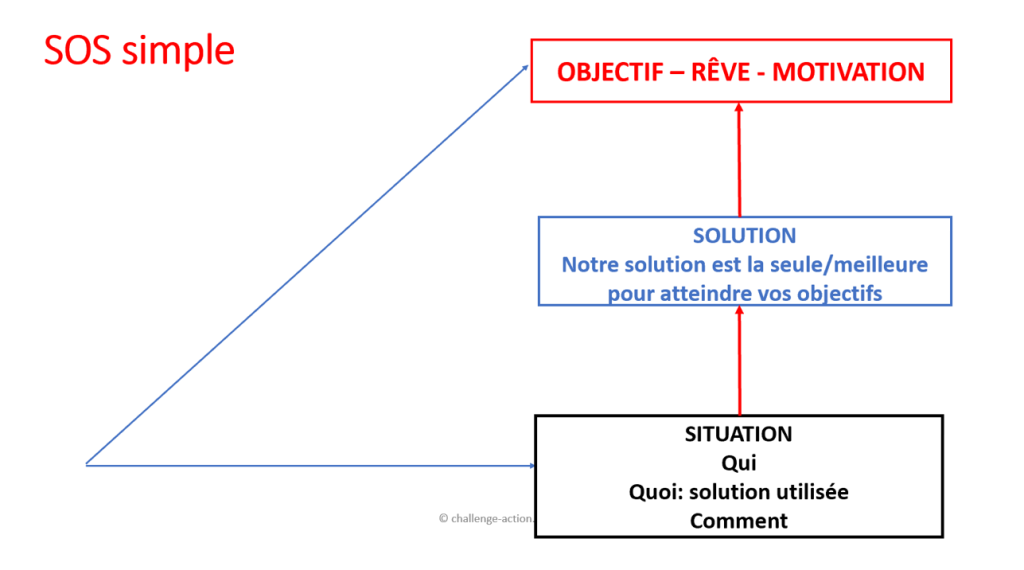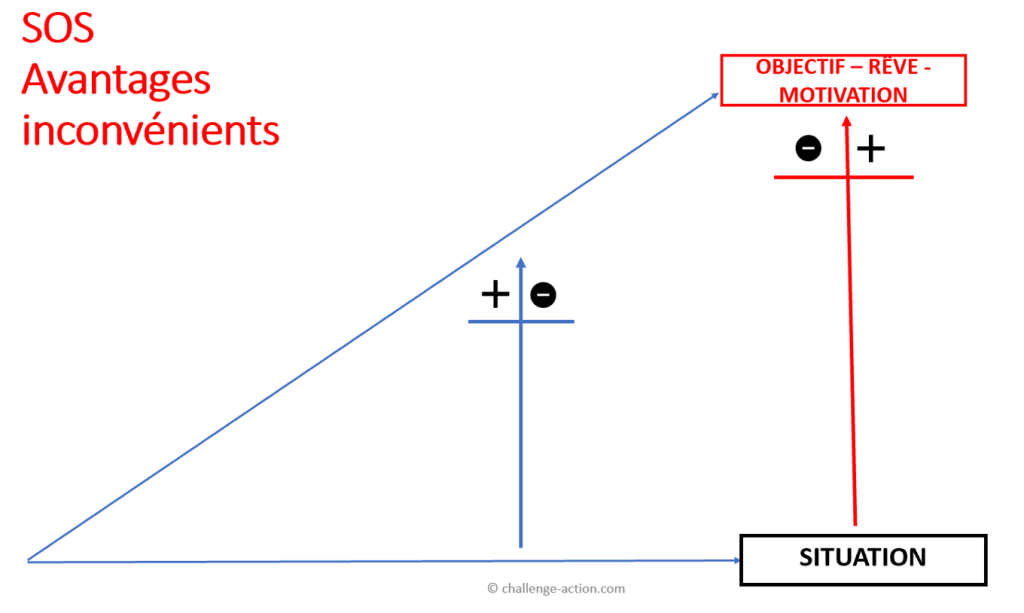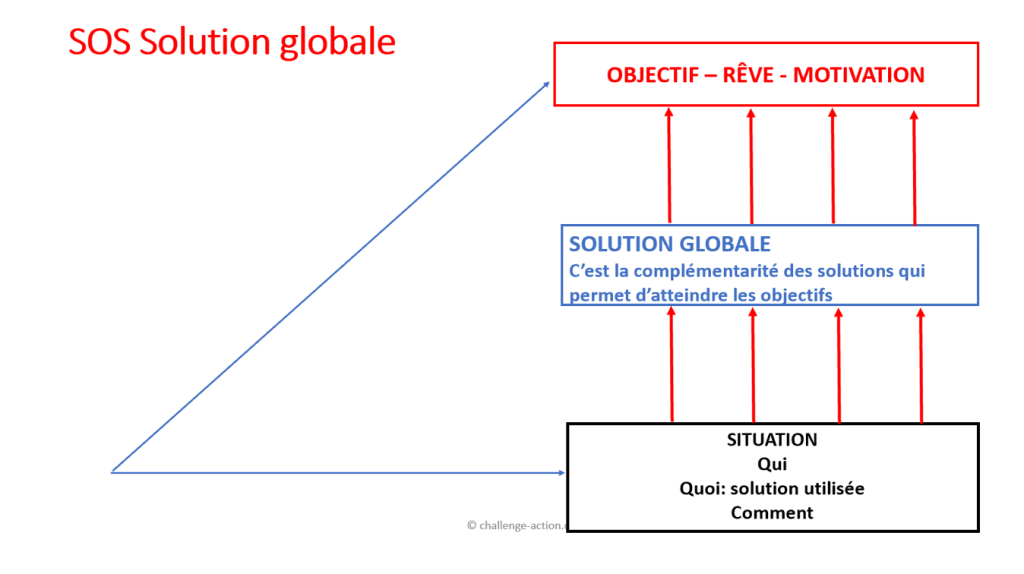I’ve had the opportunity to train thousands of salespeople in Europe and North America, and to test the different sales techniques, their advantages and disadvantages, which I present to you here. There’s no such thing as a bad one, some are clearly tried and tested, others can be combined, so it’s up to you to choose the ones that suit you best and your type of customer, the key is to increase your salesWe only do well what we enjoy!
Sales techniques and processes
- PSAI
- Problem
- Solution
- Benefits
- Disadvantages
It’s easier to sell to a customer with a problem than to a customer who doesn’t have a problem and is happy with his current situation. The technique therefore relies on the seller highlighting his current problem, even if he can’t see it. The next step is to compare two solutions for the customer: his current situation, and ours. We finish, of course, with our solution, because customers remember best what they hear last. Each solution has advantages and disadvantages, but we show that our solution has fewer disadvantages than the other solutions and, above all, greater advantages.
The method works, but has the disadvantage of showing the customer that he has a problem with his current solution, which he may not appreciate, especially if his ego is high. The SOS method, described below, solves this problem.

- SPIN
- Situation: current situation we’re trying to detail
- Problem: difficulties experienced
- Implication: unpleasant consequences of these difficulties
- Needs payoff
This is one of the methods most widely used in North America. It has demonstrated results and proposes a logical approach to customer discovery with four series of questions. The technique works very well with some customers, but is counter-productive with others whose egos are important. It puts the finger on the customer’s boo-boo and then turns the knife in the wound (spin) by focusing on the problem and above all on its negative implications, its personal or business consequences. A lot of customers hate it, so I recommend using it very carefully. Overall, the SOS method is better.
- SOS
- Situation: current situation, business situation, commercial situation, competition, HR situation, personal situation, personnel, sales.
- Objectives: dreams, desires, motivations, projects
- Solution
The SOS is the best sales technique in my opinion, because it’s pragmatic, based on the customer’s current situation, but also on their dreams, and sales is also about making them dream. What’s more, the gap between the situation and the objective is the problem, and there’s no need to talk about it. The technique isn’t aggressive for the customer, it’s much more positive. Once we’ve discovered his objective and the type of solution he prefers, all we have to do is show him that our solution is the best way to achieve his goal.

- SOSAI
- Situation
- Objective
- Benefits
- Disadvantage
The technique is the same as the SOS, but we add the advantages and disadvantages of our solution, because we’re going to compare it to the customer’s current solution or to other solutions in the competition. All that remains is to demonstrate that our solution is the best.

- SONCAS and SONCASE
- Safety: the desire to be safe
- Ego: desire to show off with the product or serviceNewness: desire to have the latest novelty, the latest gadget
- Convenience, comfort
- Affluency, money: saving or making money
- Sympathy: for the product, service or salesperson
- Ecology: the last letter added to the classic SONCAS
This is in fact a catalog of customer motivations, which are grafted onto another technique, such as the O of SOS or the A of SOSAI. The effective use of these tools requires you to detect the customer’s motivation, either because you know him or during the discovery process, which is remarkably effective. The only difficulty is that it’s often difficult for salespeople to identify one motivation out of six during their interview, but the good news is that we can reduce them to three with the SEC system.
- SICSIC
- Safety
- Interest
- Comfort
- Innovation
- Consideration
The technique is close to SONCAS, but the notion of Interest has the disadvantage of being very general and of being able to represent many things. It is less well-known and popular than SONCAS.
- SEC discovering psychological needs
- Safety: safety or the desire to save
- Ego: pride, desire for novelty to appear, ecology
- Convenience: comfort or sympathy for the product, service or salesperson
The SEC is simpler and just as effective as the SONCAS, because motivations can be grouped into just three categories, simplifying the salesperson’s work and enabling him or her to concentrate on other aspects of the sale.
- CAP
- Characteristics of the product, service, performance
- Benefits of the solution
- Proof: studies, statistics, cases of satisfied customers
It’s a structured, evidence-based argument, useful if you think the customer might not believe you. Like the CAB, it can only work for the repetitive sale of a product whose features, benefits and proofs are known. There’s not even any need for customer discovery here; it’s just the same thing over and over again, like in a commercial. It’s ideal for busy trade shows and promotional stands. I’ve never seen it applied to a complex sale.
- CAB or structured argumentation
- Characteristics of the product or service
- Advantages: generic benefits of the solution
- Benefits: specific, personalized advantages for the customer
Like the CAP method, this technique is based more on a structured sales pitch for the product, and is suited to the repetitive selling of a product with which we are familiar and whose characteristics are limited, but it is more customer-centric in that it presents specific benefits for the customer, which requires a minimum of self-discovery and understanding of his or her expectations.
- AIDA
- Attention
- Interest
- Desire
- Acquisition
This method is particularly well-suited to in-store sales, where we observe customers paying attention to a product, demonstrating their interest by stopping to look at it. All that’s left for the salesperson to do is to arouse the customer’s desire and then get them to buy. The method adapts to the client’s psychological process.
- BANT
- Budget: can you afford it? Budget: what is the budgetary impact if he doesn’t act?
- Authority: does he have decision-making power? does he need his wife’s or boss’s approval?
- Necessity: importance for him to make a quick decision
- Time: steps to close the sale
Sales technique used in some furniture stores and car dealerships. Asking for a budget helps orient the salesperson on the type of product to offer, but it’s also said that a salesperson should talk about price last, as it always seems lower after creating the need. What’s more, the notion of price is a psychological one, as customers eventually get used to a price they initially considered high. The BANT method is best suited to a busy store where the sales assistant doesn’t want to waste any time. A negative answer to the first two questions leads him to stop the conversation and look for another customer. The method is a little aggressive, and not optimal in terms of closing rates, but it does allow you to filter customers and focus on those with the greatest potential. The salesman chooses his customers to boost his personal figures, not always those of his employer.
- CCS
- Consumer
- Centric
- Selling
This is the opposite of the BANT method: each of our customers is important, we listen to them and focus on their characteristics and expectations, offering them the best service and the best solution. The aim is to satisfy them, knowing that the most profitable customers are the ones you keep loyal. The method is equally suited to B2C and B2C sales.
- ADAPAC
- Approach
- Discovery
- Abstract of the solution
- Proposal
- Argumentation
- Conclusion
A classic list of sales stages, she adds the proposal initiation and forgets the follow-up.
- SPANCO
- Suspect: target identified, but not yet contacted
- Prospect: contact with certain targets
- Analysis: of the prospect’s situation and objectives in order to make an offer
- Negotiation: proposal and argumentation and negotiation of the offerConclusion of the sale
- Closing the sale
- Order: order signature and customer follow-up to build loyalty and maximize sales
Rather, it’s a method based on the general stages of approaching and following up a customer, enabling the pipeline to be tracked in a CRM with the appropriate KPIs, and thus forecasting sales based on the sales team’s figures at each stage. This is especially useful for complex sales with a lengthy process to finalization.
In a sale, you should talk for 30% of the time and listen for 70%. In sales classes, we often hear: “We have one mouth and two ears”, “If you want to sell, shut up”. On a more technical level, customers are always more likely to believe what they say than what a salesperson tells them. Active listening is therefore a form of oriented listening that aims to get the person to express our arguments. We use techniques such as reformulation, interpretation, silence and empathy. Active listening is also used with the SOS, SOSAI, SPIN and PSAI methods, and is most effective within these persuasion structures.
Technique for selling products that complement the initial purchase. This technique is mainly used in customer service, where the customer calls for one service and is sold an additional one to increase the overall bill.
The best technique for selling a complementary set of products, smarter and more subtle than cross-selling. Instead of adding a sale to a sale that’s already been made, we come up with a global solution that makes sense, is more professional and more profitable. On the other hand, it requires in-depth discovery before proposing a global solution.

- Menu vs à la carte
An extremely effective inbound or customer service sales technique, I’ve used it to double sales in a call center. The customer calls for one service, and is sold on the benefits of additional services. When we calculate the total price with the à la carte price, the customer finds it too expensive, so we tell him we’ll see if we can find a promotional offer, i.e. the menu of the day, which includes all the required services and even an additional service at a lower price. This works as long as the company sets up these “menu of the day” offers.
- 4C
- Contact: getting it right in the first few seconds
- Capture the information, active listening
- Convincing: persuading the customer of the benefits of using our solution
- Conclude: end the process with the customer’s agreement. If this is not possible, please make an appointment for another business proposal.
A simplification of the 7 stages of the sale, giving the salesperson a clearer idea of where he or she stands in the process.
- SIMAC
- Situation
- Idea
- Mechanism
- Advantage
- Conclusion
It’s a list of the stages in the sales cycle, enabling sales reps to better structure their sales approach.
- ICEC (Inbound sales)
- Identify the customer
- Connect with the person
- Explore your needs
- Advise on the best solution
Steps for inbound sales
- DISC
- Dominance
- Influence
- Steadiness
- Conscientiousness
Instead of relying on motivation like SONCAS, we determine the customer’s personality. With the dominant, you get straight to the point, because he’s focused on his objective; with the influential, you talk about subjects that appeal to your contact, because he prioritizes the pleasure of contact; with the stable, who’s more introverted, you go into detail, securing compliance with analysis and proof.
- BOBI
- Benefits needed by the customer
- Objective
- Budget
- Identity
It takes the form of a note-taking matrix. I prefer the SOS method, which is simpler and more sequential, but that’s a matter of preference.
- Elevator Pitch
- Who we are
- What we do
- The benefits
- The benefits of prolonging the conversation for the customer
The sales pitch takes less than 60 seconds, so you need to know it inside out and describe the key points. It has to be short, punchy, persuasive.
American researchers Dixon and Adamson classify salespeople into 5 types
- Worker
- Lone wolf
- Relationship
- Problem solver
- The Challenger that puts everything in question
They then identify 5 steps to follow:
- Warming the climate
- Reframing the conversation
- Using emotions
- Demonstrate the benefit the customer is looking for in the long term
- Propose the product
The technique is currently in vogue, but has a number of shortcomings:
- Complicated to use
- In fact, it simply follows the SOS method by making it more complex.
- It gives too much importance to the preliminaries and forgets the key stages of responding to objections, the conclusion and the follow-up.
Sales support tools
Paper brochures have almost completely disappeared, as they are expensive and not very environmentally-friendly, and have been replaced by PowerPoint presentations, either face-to-face or remotely. The website also enables B2C consumers to consult catalogs with constantly updated information.
Business cards are always present, and some people scan them to keep them without using the old Rolodexes.
The best tools are still CRMs
- Actionclient
- Avantages : le plus simple, le plus orienté sur la vente et les réalités du vendeur, version gratuite et prix très abordable pour un travailleur indépendant ou une PME. Les principales fonctionnalités de classements:
- List of prospects
- ProspectsCustomers
- Current proposals
- Follow-up
- Each customer file is identical and contains all the customer’s documents.
- Each customer file has a contact history
- View of actions to be carried out by customer file or by global table
- Import customers one by one or by list
- Disadvantage: doesn’t have all the features of a large CRM
- Avantages : le plus simple, le plus orienté sur la vente et les réalités du vendeur, version gratuite et prix très abordable pour un travailleur indépendant ou une PME. Les principales fonctionnalités de classements:
- Sales force
- Advantages: the best-known CRM, it covers a very wide target, adapts to company needs, and offers all functions.
- Disadvantages: often expensive, you have to pay for adaptations and training, salespeople often find it complex and feel they spend more time filling it out than selling it.
- Microsoft Dymanics 365
- Advantages: the most comprehensive and largest CRM, the one used by the biggest companies, customizable interface, available in almost every language.
- Disadvantages: there are so many features that the tool makes Sales Force look simple by comparison. The tool has a lot of potential, and the organization that buys it can either simplify it or make it more complex – it’s often the latter.
- Hubspot
- Advantages: flexible, it can be integrated with many other software programs, and its ergonomics are more modern than those of other large systems.
- Disadvantages: the entry fee is fairly high, and not affordable by all small businesses.
In conclusion
There are many different sales and CRM techniques, but the best is what works best for you and your customers. Try new things and see what works best. Selling is a game, and I also say that you only do well what you like well.
Good sales!
Jean-Pierre Mercier
List of sales methods and techniques proposed by Challenge-Action
